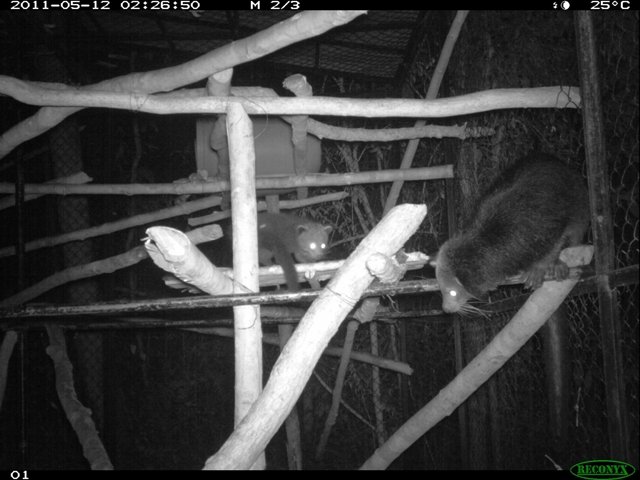By Michael Zwirn | Director US Operations
Our Care for Rescued Wildlife program pledges lifelong support for rescued wildlife if needed, but our goal whenever possible is to release healthy animals back into their native forest habitat. How does this all happen?
The key infrastructure to make this possible is at our remote Wildlife Rehabilitation Station in the Cardamom Mountains. There, we bring animals after their rescue and rehabilitation in preparation for release, and continually monitor their health. In the first quarter of the year, Wildlife Rescue director Nick Marx monitored the previously released porcupines, parakeets, and hill mynahs - all were staying nearby, but no longer dependent on food. The previously released greater coucal has not been seen in months. He was a capable bird, we could do no more for him and we have to hope he has survived and moved on to another site.
In January we took five more injured porcupines that could not be released immediately to the Rehabilitation Station. They recovered and were soon ready to go. The Wildlife Rapid Rescue Team confiscated 22 long-tailed macaques from traders in February. Most of these were too young for release but we took them to the Rehabilitation Station where they will mature before release. Although they came from the wild and are still very frightened of people, we must hope they do not become too accustomed to human visitors during their time with us.
Towards the end of February, Wildlife Alliance’s veterinarian, wildlife biologist, and Wildlife Rescue Director Nick Marx traveled to fit radio collars on our pair of binturongs that we took down almost exactly one year ago. They had a baby last year, and we hoped to release the family as a group, as the youngster is still only around six months old.
The Wildlife Rehabilitation Station is ideal for releasing animals. The forest is alive with birds and a tiny sunbird couple has built a nest in the small clump of brush besides the WRS camp, a long beak poking out of the untidy cluster indicating someone was home. It is a tranquil environment - protected from hunting and habitat encroachment, and monitored continually by a group of wildlife specialists.
We fitted the collars to the “bintys” and had returned to the daily grind “up country” when Mr. Goeurn, one of our staff members at WRS, notified our wildlife biologist that more baby binturongs had been born. This seemed to be a little soon after the first, but we could do nothing about it. The binturong release had been delayed for too long already, so on March 7th our staff traveled to Chi Phat, just before the start of the heavy seasonal rains. The skies opened up and the truck got stuck when we left the main road. Outside of the rehabilitation enclosure, we set up two camera traps graciously lent to us from the Wildlife Conservation Society, opened the cage slide door and returned to camp to cook an evening meal.
The next morning the male and older baby were sitting on branches just beside the enclosure, the female was in her nesting barrel with her new babies. A second check on the binturongs during the day revealed that the mother had left the enclosure. By nightfall she had not returned. I was worried about the new infants, only around three weeks old, but we did not interfere. The following morning our worries were over. Mother had returned to care for her babies.
We had fitted the binturongs with radio collars to track their health and whereabouts. The collars we fitted give us two options for tracking the animals: One is regular VHF monitoring using an antenna to follow the signal. The second is by GSM, whereby the binturongs’ positions are downloaded and sent to us by email each day. The idea is not necessarily to see the animals firsthand – this is usually impossible in dense forest – but to know they are moving around and coping.
The way points we have received reveal that the female has not gone far from the enclosure and her new babies. The male has been moving around a little further afield. We have not seen the first born youngster as our camera traps are not functioning properly. However he may well be returning at night to eat the food that we are putting inside the cage for them all, some of which is disappearing. There have been some heavy downpours and the rainy season is just starting in Koh Kong, but binturongs don’t seem to care rain, preferring to remain in the tree tops whatever the weather rather than take shelter. It is an ideal time for release. There is an abundance of wild forest fruit available at present so there is every chance that our captive born bintys, mother, older baby and his father, who has now circled around in a radius of around 1km and returned close to the enclosure, will be fine.
We have shipped a new batch of camera traps and memory cards from the United States to improve our ability to monitor the released wild animals. Between camera traps, radio collaring, visual observation, and other assessments, we will be able to ensure the best possible life for all the animals we have rescued, cared for, rehabilitated, and released.
Links:
Project reports on GlobalGiving are posted directly to globalgiving.org by Project Leaders as they are completed, generally every 3-4 months. To protect the integrity of these documents, GlobalGiving does not alter them; therefore you may find some language or formatting issues.
If you donate to this project or have donated to this project, you can receive an email when this project posts a report. You can also subscribe for reports without donating.
Support this important cause by creating a personalized fundraising page.
Start a Fundraiser